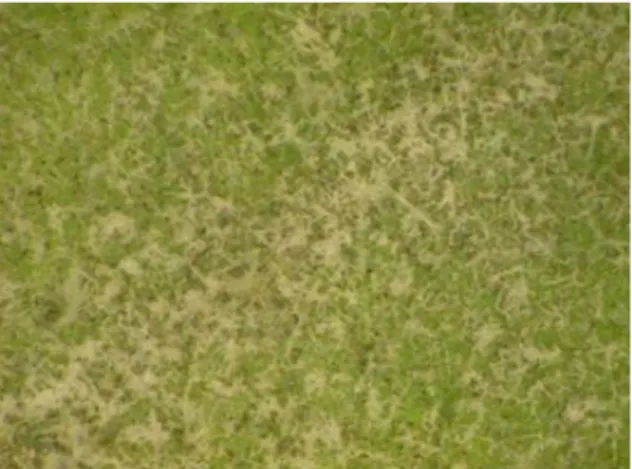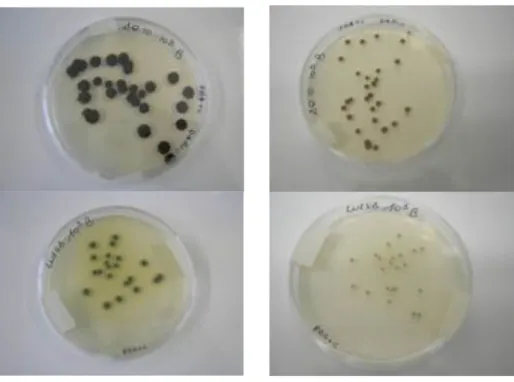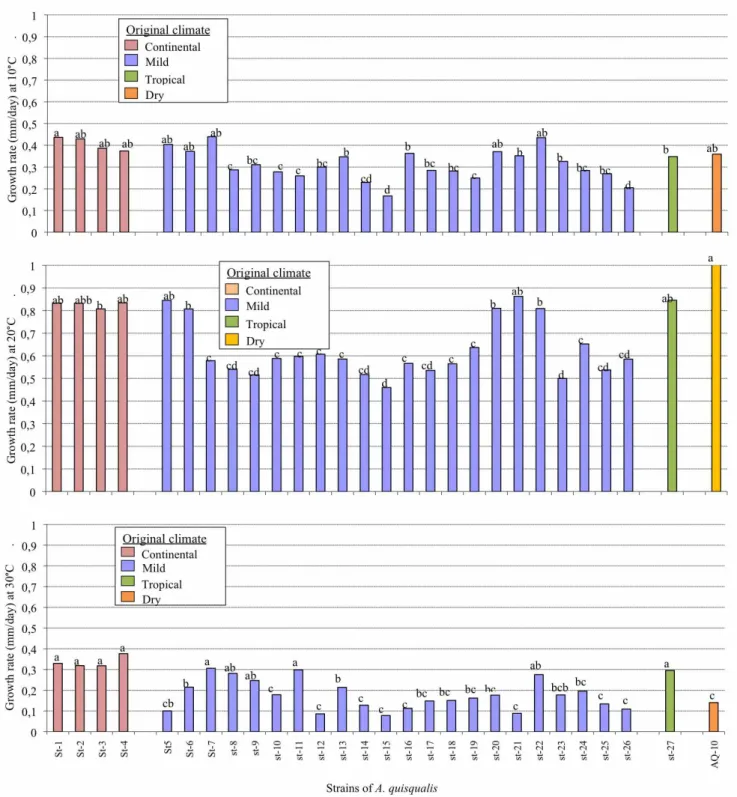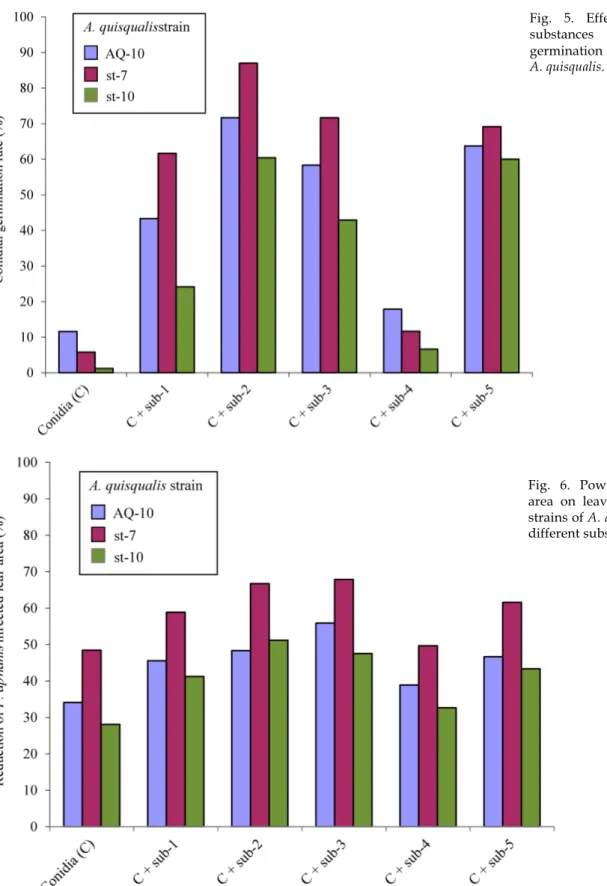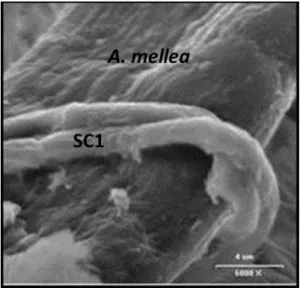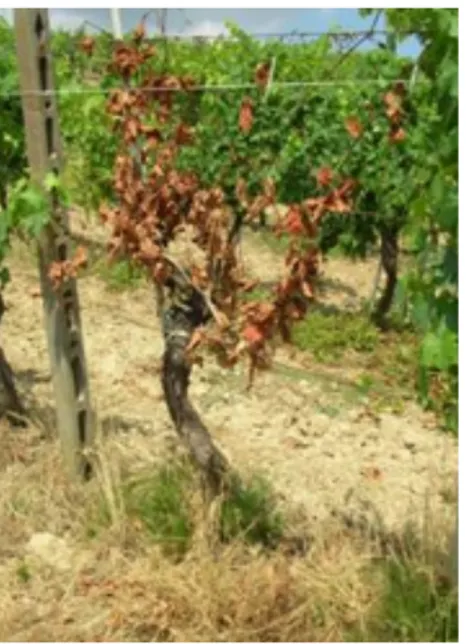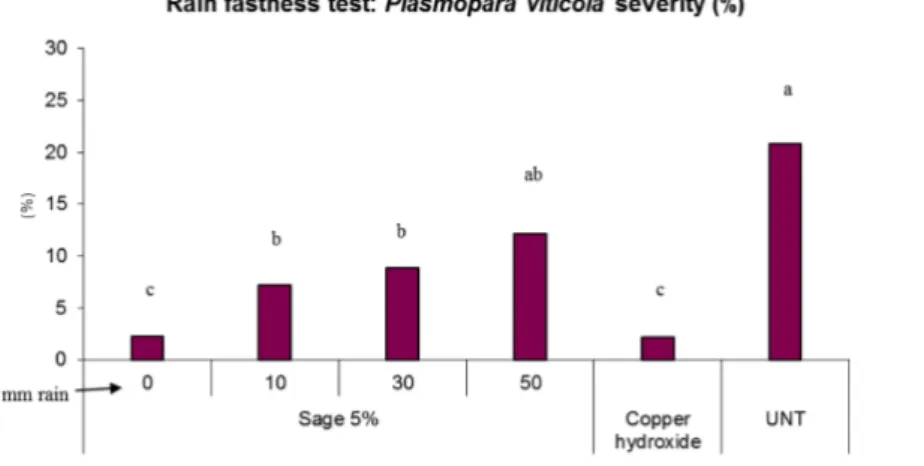ALTERNATIVE TOOLS IN AGRICULTURE
Plant diseases as downy mildew and powdery mildew will increase with the temperature rise, as projected in the climate change scenarios. Alternative tools as mycoparasitic fungi and botanicals can be used to control these grapevine pathogens. Fungi belonging to the Erysiphaceae and Peronosporaceae are the causal agents of powdery and downy mildews, among the most damaging plant diseases worldwide Key‐featuresAscospores released from a Erysiphe necator chasmothecia 1. Protecting the crops: biological control agents
At present plant protection against diseases is mainly based on the use of chemical fungicides. To reduce the use of pesticides, several environmental friendly products have been evaluated for controlling pathogens (Paulitz and Belanger, 2001; Gilardi et al., 2012). Among these products, biological control agents (BCAs) are important tools for biological crop protection. The use of BCAs represents a good alternative to chemicals in crop protection against weed, insects, and disease in both agriculture and forestry. This approach is based on the knowledge of natural interaction between pests or pathogens and their natural enemies. Four different mechanisms for controlling pests or diseases by BCAs are known: 1) antibiosis, with the inhibition of the pathogen by the production of metabolites; 2) competition, as a negative interaction that occurs among organisms whenever two or more organisms require the same limited resource;
In the present study the efficacy of several biocontrol agents was tested on powdery and downy mildew, Armillaria root rot and Esca disease under controlled conditions. The mycoparasitic fungi Ampelomyces quisqualis and Trichoderma atroviride and essential oils extracted from Salvia officinalis were select for the biocontrol experiments. Armillaria mellea and Esca disease are grapevine wood diseases, which represent two serious diseases in some grape‐growing regions. Both fungi seriously affect vine yield and longevity
2
www.envirochange.eu
2. Ampelomyces quisqualis
3) mycoparasitism, the direct attack on the pathogen using it as nutrition source; 4) induction of resistance, as a defence response to the pathogen activated by beneficial microorganisms or their metabolites.
Some of the beneficial organisms used in the biocontrol are mass produced and available for large-scale distribution in crops with the aim of reducing damaging population. These organisms include strains belonging to bacterial genera such as Agrobacterium, Pseudomonas, Streptomyces and Bacillus, and fungal genera such as Gliocladium, Ampelomyces, Trichoderma, Candida and Coniothyrium.
In the following pages three main biofungicides are described: Ampelomyces quisqualis, Trichoderma atroviride (BCAs) and Salvia officinalis extract (botanical).
This research is part of the Envirochange project, where global change and sustainable management of agriculture in highly developed mountain environment are studied.
Metabolite: a small molecule with various functions as fuel, structure, signaling, stimulatory and inhibitory effects on enzymes, catalytic activity
of their own, defense, and interactions with other organisms (e.g. pigments, odorants, and pheromones). Alcohol is an example of a metabolite produced industrially. Secondary metabolites have
important ecological functions, as for example antibiotics. (adapted from
http://en.wikipedia.org/wiki/Metabolite). Strain: a genetic variant or subtype of a
micro-organism.
Genera: in the hierarchy of biological classification's a genus is a major taxonomic ranks grouping species similar to each other. E.g. a horse
and a dunkey are part of the same genus (Equus) but of different species.
Powdery mildew: is a disease affecting different plants. It is caused by different species belonging to
the order Erysiphales. Disease sympoms are white powdery spots on the leaves, flowers, young fruits
and stems.
Ampelomyces quisqualis is a natural occurring mycoparasite, considered as one of the best alternatives to chemicals against Erysiphales, the casual agents of powdery mildews that are among the most dangerous plant diseases worldwide.
It does not negatively impact human health and the environment. A. quisqualis invades and grows within powdery mildew hosts; parasitized powdery mildew colonies are dull, flattened and off-white to grey in colour (Figs. 1, 2). Several A. quisqualis strains are available in culture collections. One strain isolated in Israel has been formulated, registered and commercialized under the trade name of AQ10 (Kiss 1997; Sztejnberg 1993).
AQ10 is widely used to control powdery mildew of various crops, but report data on the effectiveness in the powdery mildew control by AQ10 application are contradictory (Angeli et al. 2009; Gilardi et al. 2012).
Fig. 2. Powdery mildew chasmothecia parasitized by Ampelomyces quisqualis conidia Fig. 1. Powdery mildew mycelia parasitized by Ampelomyces quisqualis
2.1 Ampelomyces quisqualis in changing climatic conditions Climate change and predicted increases in
temperature may strengthen the severity of powdery mildews and influence the survival of microbial agents in the environment (IPCC Climate Change, 2007; Houghton et al., 2001). Changes in temperature are known to affect the populations of microrganisms living on plant surfaces and greatly influence, consequently, the efficacy of BCAs (Elad, 2009; Drigo et al., 2008). For the future it is important to select new BCAs adapted to the climatic conditions and effective in the biocontrol of diseases. Temperature is an important limiting factor in the use of A. quisqualis in biocontrol.
This research has focused on the development of new strains of A. quisqualis, which can be used in the field to control powdery mildews. We also investigated if there is a different temperature adaptation of different strains of A. quisqualis isolated from different geographic sites. Our experiments showed that temperature greatly influences the growth rate of A. quisqualis (Fig. 3) on Petri dishes and strains isolated from different climatic areas (continental, mild, tropical and dry climate) grow at different rate (Fig. 4).
The highest growth rates of A. quisqualis were measured at 20°C for all strains, whereas a strong reduction of growth rates was measured at extreme temperatures of 10 and 30°C.
The original climate at which A. quisqualis strains are isolated did not influence its adaptation to temperature. In fact, strains isolated in countries with a warm climate grew well at low temperature and vice versa.
Fig. 3. Growth rate of two strains of A. quisqualis (strain AQ10 on the left, strain st-7 on the right) under 20 and 10°C, respectively.
Three of the tested A. quisqualis strains were selected in experiments, which aimed at verifying if it is possible to enhance the efficiency of this fungus in the biological control of powdery mildews by increasing the conidial germination rate of the fungus. Suspensions of A. quisqualis conidia and different substances stimulating germination (sub 1-5) were incubated for 24 hours at 25°C and then sprayed on strawberry plants in greenhouse.
4
www.envirochange.eu
Fig. 4. Radial growth rate (mm/day) of 28 strains of A. quisqualis at three different temperatures (a, b, c).
Untreated conidia were used as control. All the tested substances increased the germination rate of the A. quisqualis strains (Fig. 5). However, significant differences in the induction of germination were detected among the different substances. The conidial germination of strains was stimulated more strongly by sub-2 (60.4-87%) and less affected by sub-4 (6.6-17.9%).
Moreover, differences among the conidial germination rates of the different strains were identified, independent of the type of substance. AQ10 exhibited significantly lower germination rates and less tube elongation in the presence of several substances stimulating conidia, as compared to the strain st-7.
Biocontrol experiments against strawberry powdery mildew (Podosphaera aphanis) showed that the ability of A. quisqualis to reduce infections can be increased by the presence of the substances promoting conidia germination (Fig. 6). All tested strains showed a reduction of infected leaf area after stimulation with different substances. However, strains differ in their
aggressiveness and st-7 was more effective than st-10 and the commercial strain AQ-10. Best results were obtained with st-7 stimulated by sub-2 and sub-3 which strongly reduced the infected leaf area (67 and 68%, respectively). A. quisqualis conidia stimulated by sub-2 and sub-3 increased the reduction of mildew infections of more than 20% in comparison to the control (untreated conidia).
Fig. 6. Powdery mildew infected area on leaves sprayed with three strains of A. quisqualis stimulated by different substances.
Fig. 5. Effects of five different substances on the conidial germination (%) of three strains of
6
www.envirochange.eu
3. Trichoderma atroviride
Lytic enzymes: enzymes which can degrade cell wall of other organism
ITS sequence: internal transcribed spacer wich refers to a piece of non-functional RNA situated between structural ribosomal RNAs on a common
precursor transcript Among relevant soilborne plant pathogen,
Armillaria spp. represent an important problem in Trentino region (Northern Italy), where the present study took place.
Armillaria spp. are sapro-parasitic basidiomycetes that can survive in the soil for long time on wood and root debris in the absence of any living host (Fox, 2000). These pathogens are the causal agent of root rots of several woody plants, including highbush blueberry (Vaccinium corymbosum) (Caruso, 1995).
One of the causes of Armillaria root rot diffusion on highbush blueberry is the use of infected coniferous barks as mulch. They are collected by growers in the forest and spread in field to control weeds and preserve low soil acidity.
No chemical agents are available for use against Armillaria spp. and the common fungicides were found to be ineffective against this pathogens. (Aguin-Casal et al., 2006). Several species of the fungal genus Trichoderma are good antagonists of these pathogens (Hjeljord and Tronsmo 1998). They are competitors for space, nutrients and produce lytic enzymes (Elad 1996). In particular, Trichoderma atroviride strain SC1 was isolated in Northern Italy in 2000 from decayed hazelnut wood. The strain was morphologically identified as T. atroviride P. Karst., and its identity was confirmed through ITS sequence analysis. SC1 was deposited in the Centraalbureau voor Schimmelcultures (CBS) restricted collection (number 122089) and it is stored in the fungal collection of FEM Research and Innovation Centre.
T. atroviride SC1 is effective against several diseases, Armillaria root rot included.
Trichoderma atroviride strain SC1 does not easly survives on rizosphere, but the bark of conifer seems to be an appropriate substrate, which enhance the growth rate of the fungus and can therefore offer a solution to this problem.
Fig. 8. Parasitic interaction of Trichoderma
atroviride SC1 in contact with Armillaria mellea
immage obtained by scanning electron microspcope
Fig. 7. Antagonism activity of Trichoderma
atroviride SC1 versus Armillaria mellea in Petri
The study demonstrates that no differences in damage level exist between highbush blueberry cultivated into Armillaria gallica infected soil or in healthy soil mulched by infected coniferus barks. The use of pre-treatment barks with SC1 is an interesting agronomic practice. The antagonism trials in vitro have demonstrated that there are no differences of efficacy of T. atroviride SC1 on three different types of barks (larch, pine, fir
and mixture) in the control of A. gallica. The inhibition of pathogen growth was around 90%. T. atroviride SC1 can survive and grow on all types of bark for a long time after treatment but for a minor time on fir bark (Fig. 5). After inoculation (0 weeks), the Trichoderma concentration was about 5 × 105 colony forming unit per gram (CFU/g) of dry substrate and it increases rapidly to 106-107 CFU/g on different type of barks after two weeks.
Fig. 9. Development of T. atroviride SC1 on the different coniferous barks.
Greenhouse experiments were performed to observe the development of disease on strawberry plants mulched with mix bark pre-inoculated with SC1 and infected with A. gallica. SC1 reduced disease incidence from 70% (untreated bark) to 25% (treated bark with SC1).
In another trial we studied the efficacy of T. atroviride SC1 in the control of Esca disease, which causes damage in vineyards in several parts of the world. The disease is caused by three different fungi: Phaeomoniella chlamydospora, Phaeoacremonium aleophilum and Fomitiporia mediterranea). These pathogens affect the shoot of the trunk and the branches with chronic or acute evolution (Fig. 6).
At the moment the prevention of pruning wound infections by following correct cultural practices represent the main way to manage the disease but the introduction of microorganisms such as BCAs represents an interesting alternative or complementary strategy.
Fig. 10. Grapevine pruning wounds infected by esca fungi.
8
www.envirochange.eu
Tab. 1. Percentage of incidence of T. atroviride SC1 at February in pruning wounds at different distance to the inoculum point.
We have examined the activity and survival of T. atroviride strain SC1 as BCA to reduce the potential infections of esca fungi on grapevine pruning wounds. We studied the survival of T. atroviride SC1 on pruning wound vineyard (107 conidia/ml) applied during winter season and its efficacy to reduce the colonization of P. aleophilium and P. chlamydospora of grapevine pruning wounds in potted plants.The results obtained are very interesting: T. atroviride SC1 is able to reduce the development of esca fungi in vitro and on potted plants and it is very effective in the inhibition of the growth of P. aleophilum (85.9%) on pruning wounds.
T. atroviride SC1 survived for a long time (90 days after inoculums) into the shoot (Tab. 1), assuring by this way a potential protection of pruning wounds versus Esca fungi infection. However, the percentage of colonised wounds decreases during time, probably because of the temperature rise in the vineyard. In the future, 45 different ingredients (wetting agents, UV protectors, nutritional factors, etc.) will be tested in the formulation of a semi-commercial product based on T. atroviride SC1 with the aim to improve its germination and persistence on pruning wounds.
4. Botanicals and Salvia officinalis
Herbs and aromatic plants could be potential sources of natural compounds to be used in agriculture against the main diseases. The antimicrobial activity of essential oils of these plants has been studied extensively for medical use, while there are still few studies on the control of plant pathogens.
An example of a promising group of these plants is the family of Lamiaceae. It contains about 7000 species, frequently aromatic plants, and includes many widely used culinary herbs; the chemical composition and activities of its members have been widely studied, including sage (Salvia officinalis), oregano (Origanum vulgare), thyme (Thymus vulgaris), rosemary (Rosmarinus officinalis), lavender (Lavandula officinalis) and others.
The genus Salvia includes nearly 900 species worldwide. The compositions of essential oils and extracts of some species of this genus have been adressed in many publications; the molecular composition of extracts depends on several factors as morphological and genetic variability, geographical origins, climate conditions and cultural management in addition to the time of harvest and the specific plant organ. The natural compounds present in S. officinalis have shown an efficacy in vitro against some human pathogen and phytopathogens such as Botrytis, Penicillium, Aspergillus, Cladosporium, Fusarium, and Phytophthora. Studies in planta have demonstrated the properties on disease control of sage extract against Pseudoperonospora cubensis, Peronospora destructor, Bremia lactucae and Phytophthora infestans.
Ethanol extract of Salvia officinalis, obtained with Soxhlet method, has shown high activity against Plasmopara viticola, the causal agent of grapevine downy mildew, one of three main grapevine diseases that can cause high qualitative and quantitative production losses. This extract may be the key to the reduction of the use of copper, the main product used in viticulture against this disease that causes various problems at the living forms of soil.
www.anbanet.com Essential oil
A concentrated hydrophobic liquid containing volatile aroma compounds generally obtained
by distillation of plants or part of these. Soxhlet method
Extraction method that uses the Sohxlet extractor in order to pull out the compounds present in a dried organic matrix through an extracting solvent (alcohol, hexane, chloroform,
etc.). In few hours, this apparatus allows to do more cycles of extraction and obtain a
concentrated extract.
Fig 12. Oil spots typical of grapevine downy mildew on leaf.
Fig 14. Salvia officinalis leaves used to obtain the crude sage extract.
Fig 13. Symptoms of
Plasmopara viticola on
10
www.envirochange.eu
4.1 Salvia officinalis
Among the main characteristics of the plant extracts usable in crop protection, the high eco-compatibility and biodegradability represents the strong point of these products. This property allows reducing or avoiding the residues of chemicals on crops in harvest time, resulting in a better salubrity for consumer. However, this feature could have a downside: these products are very susceptible to weather conditions and their effectiveness is particularly affected. Precipitation, temperature and photo-degradation are factors that can reduce the permanence of vegetable extracts on the treated plants and, for this reason, their actual influence must be quantified.
The crude sage extract has been chosen between the various plant extracts for its high activity against grapevine downy mildew and was subjected to tests of persistence and rain fastness in greenhouse so as to evaluate the possible solidity in field under different weather conditions.
We have been used the Soxhlet extractor with ethanol absolute in order to pull out the natural compounds present into the dried leaves of S. officinalis, as described in the work of Dagostin et al. (2010).
The sage extract has been sprayed on the grapevine plants (Pinot gris cultivar on Kober 5BB rootstock) with a sprayer before inoculation with P. viticola.
The optimal concentration of sage extract has been detected with an effectiveness test comparing the plant extract to a commercial formulation of copper hydroxide (Kocide 3000; 2,5 g/l; Du Pont) and an untreated thesis. After the incubation period and sporulation of downy mildew, the severity and incidence of disease have been assessed.
Fig 16. Antifungal activity of several concentrations of sage extract against
Plasmopara viticola; evaluation (%) of disease
severity and incidence (ANOVA p < 0.05, test
HSD Tukey = 0.05).
Fig 15. Soxhlet extractor and the crude sage extract; the dried leaves of sage are into the porous
The activity of the sage extract against P. viticola is similar or better than copper and the higher concentration of plant extract (5%) allows reducing considerably the infections of downy mildew.
To guarantee a prolonged protection over time understanding if this extract is able to persiston the leaf in field condition is crucial. For this reason some tests were performed to evaluate persistence and resistance to rainfall of the above-mentioned extract. The sage extract is a preventing product
(such as copper) and the techniques used in crop protection indicate a protective stage of one week for this kind of products. In the persistence test, plants were treated only once to 6, 3, 2, 1 days and 6 h before to inoculation with P. viticola; in this period the plants were kept in greenhouse at 25°C to avoid the wash-off of product caused by the rainfall.
The activity of sage extract is very persistent; the efficacy is very similar to copper products used 6 hours before the inoculation and remains constant for a week.
Fig 17. Persistence of efficacy of crude sage extract (dosage 5%) on leaf against
Plasmopara viticola; evaluation (%) of
disease severity and incidence (ANOVA p
< 0.05, test HSD Tukey = 0.05).
The other evaluated factor was rainfastness; the rainfall can wash-off of the plant extract and so reduce the quantity present on the leaves. The treated plants have been subjected to 0, 10, 30 or 50 mm of simulated rain applied
using an irrigation system with sprinklers. After receiving the simulated rainfall, plants were left to dry and then inoculated with the pathogen.
Fig 18. Rain fastness of crude sage extract (dosage 5%) at several quantity of rainfall; evaluation (%) of grapevine downy mildew severity and incidence (ANOVA p
12
www.envirochange.eu
Fig 19. Comparison of crude sage extract (dosage 5%) with a commercial
formulation of copper hydroxide in rainfastness test: evaluation of antifungal effectiveness against Plasmopara viticola.
Crude extract has shown a poor persistence against rainfall; the effectiveness of the product drops down already after a few millimeters of rain; with 10 mm we have recorded a reduction of the 25% in the efficacy and about 50% with 50 mm.
Primary infection of P. viticola can be achieved already with a rainfall of 8-10 mm; therefore, by using a crude extract in field, we may have
a low protection when the climate conditions are very favourable for the disease (rain and wet leaves).
In the tipical conditions of a mediterranean climate (low rainfall) the crude extract can protect vineyards against downy mildew while in a rainy continental climate should be formulated to increase the rain fastness and improve the efficacy over time.
To know more
Aguin-Casal, O., Mansilla-Vazquez, J.P., Sainz-Oses M.J., 2006. In vitro selection of an effective fungicide against Armillaria mellea and control of white root rot of grapevine in the field, Pest Manage. Sci. 62, pp. 223–228.
Angeli, D., Pellegrini, E., Micheli, S., Ress, D., Maurhofer, M., Pertot, I., Gessler, C., 2009. Molecular characterization of Ampelomyces spp. isolates from different host and geographic origin and evaluation of their potential to control powdery mildew of cucumber. IOBC/WPRS bulletin 43, 40–44.
Caruso, F., L., 1995. Armillaria root rot. In: Caruso FL, Ramsdell DC, eds. Compendium of Blueberry and Cranberry Diseases. St. Pauls, USA: APS Press, 22-23.
Drigo B., Kowalchuk G.A. and van Veen J.A., 2008. Climate change goes underground: effects of elevated atmospheric CO2 on microbial community structure and activities in the
rhizosphere. Biol. Fert. Soils 44: 667–679.
S. Dagostin, T. Formolo, O. Giovannini, A. Schmitt and I. Pertot, 2010. Salvia officinalis extract can protect grapevine against Plasmopara viticola. Plant Dis., 94, pp. 575–580
S. Dagostin, H. Schärer, I. Pertot and L. Tamm, 2011. Are there alternatives to copper for controlling grapevine downy mildew in organic viticulture? Crop Protection, 30 (7), pp. 776– 788
Elad, Y., Rav David, D., Levi, T., Kapat, A., Kirshner, B., Gorin, E., Levine, A., 1998. Trichoderma harzianum T39 - mechanisms of biocontrol of foliar pathogens. Modern Fungicides and
Antifungal Compounds II, Intercept Ltd, Handover, Hampshire, UK, pp. 459-467. Elad Y., 2009. Effect of climate change on phyllosphere microflora: Plant-microorganism interactions. IOP Conf. Ser.: Earth Environ. Sci. 6 372014.
Fox, R.T.V., 2000. Cultural methods to manage Armillaria, in Armillaria Root Rot: Biology and Control of Honey Fungus, Andover, UK, Ed. Roland T.V. Fox, Intercept Limited, pp. 151-171. Gilardi, G., Baudino, M., Garibaldi, A., Gullino, M.L., 2012. Efficacy of biocontrol agents and natural compounds against powdery mildew of zucchini. Phytoparasitica 40, 147–155.
Hjeljord, L., Tronsmo, A., 1998. Trichoderma and Gliocladium in biological control: an overview. In: C.P. Kubicek and G.E. Harman, Editors, Trichoderma and Gliocladium, Enzymes, Biological Control and Commercial Applications vol. 2, Taylor and Francis, London, pp. 131–151 Houghton J.T., Ding Y., Griggs D.J., Noguer M., van der Linden P.J. and Xiaosu D., 2001. Climate change 2001: the scientific basis (Houghton J.T., Ding Y., Griggs D.J., Noguer M., van der Linder P.J., Dai X., Maskell K. and Johnson C.A., eds), pp. 1–83. Cambridge University Press, Cambridge, UK.
Kiss, L., 1997. Genetic diversity in Ampelomyces isolates, hyperparasites of powdery mildew fungi, inferred from RFLP analysis of the rDNA ITS region. Mycological Research 101, 1073–1080.
IPCC Climate Change, 2007. Synthesis report. Summary for policymakers. Available at
http://www.ipcc.ch (accessed November 2007)
M. Ollanketo, A. Peltoketo, K. Hartonen, R. Hiltunen and M.-L. Riekkola, 2002. Extraction of sage (Salvia officinalis L.) by pressurized hot water and conventional methods: antioxidant activity of the extracts. Eur. Food. Res. Technol., 215, pp. 158-163.
Paulitz, T.C., Bélanger, R.B., 2001. Biological control in greenhouse systems. Annual Review of Phytopathology, 39, 103–133.
Sztejnberg, A., 1993. Ampelomyces quisqualis AQ10, CNCM I-807, for biological control of powdery mildew. US patent no. 5190754.
www.envirochange.eu EnviroChange is coordinated by: • Fondazione Edmund Mach‐Istituto agrario di S. Michele all'Adige (FEM, http://www.fmach.it), Research and Innovation Centre, Italia Scientific coordinator: Ilaria Pertot, [email protected] Partners: • Fondazione Bruno Kessler (FBK, http://cit.fbk.eu/en/home), Italia Scientific partner: Cesare Furlanello, [email protected] • Agricultural Research Organization (ARO, http://www.agri.gov.il/en/departments/12.aspx), The Volcani Center, Israel Scientific partner: Yigal Elad, [email protected] • Swiss Federal Institute of Technology Zurich (ETH, http://www.path.ethz.ch), Institute of plant sciences, Switzerland Scientific partner: Gessler Cesare, [email protected] • Università degli studi di Trento, (UNITN, http://portale.unitn.it/deco), Dipartimento di economia, Italy Scientific partner: Roberta Raffaelli, [email protected] The project is funded by Provincia Autonoma di Trento, Italy
THE ENVIROCHANGE PROJECT
Authors of this essay are: Dario Angeli ([email protected]), Alberto Pellegrini ([email protected]), Oscar Giovannini
([email protected]) Fondazione Edmund Mach
This work is licensed under the Creative Commons Attribution 3.0 Unported License. To view a copy of this license, visit http://creativecommons.org/licenses/by/3.0/ or send a letter to Creative Commons, 444 Castro Street, Suite 900, Mountain View, California, 94041, USA. All the images are property of Fondazione Edmund Mach, or from open sources. In any other case, pictures are courtesy of the authors and they are quoted in the caption.
Editing by Federica Manzoli: [email protected]. The EnviroChange project focuses on global change and sustainable management of agriculture in highly developed mountain environment.
It aims at assessing the short‐term biological, environmental and economic impact of climatic change on agriculture at the level of the Trentino region particularly on quality
and pest management that are more likely to be influenced by climate change in the short term. The final aim is to preserve and improve the quality of life of habitants, protecting environment and biodiversity for the future generations, as well as to represent a model for sustainable development of mountain areas.
Published by Fondazione Edmund Mach September 2012
